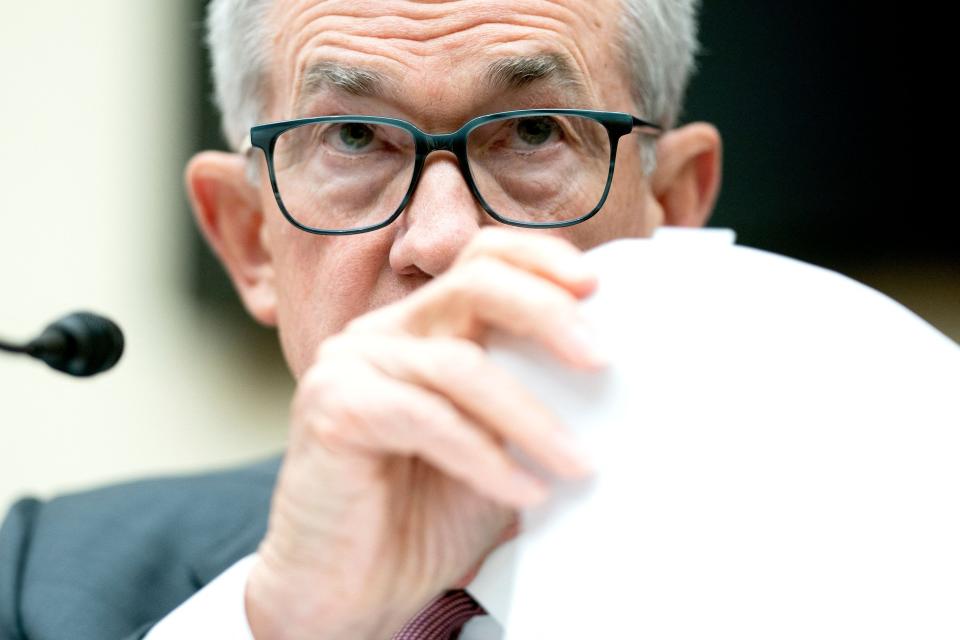Lower interest rates are coming. What does that mean for my money?
Interest rates are higher than they’ve been in more than 20 years after a historic run of rate hikes by the Fed to cool surging inflation.
But the campaign of rate increases is probably over, Federal Reserve Chair Jerome Powell signaled on Wednesday. What’s more, Fed officials predict they will lower the benchmark federal funds rate by three-quarters of a percentage point next year, bringing it down from a 22-year high of 5.25% to 5.5% to a range of 4.5% to 4.75%.
How should ordinary American investors respond?
“Your finances are all tied in some way to interest rates, and the anticipation of lower interest rates could lead to a vastly different financial landscape than we are seeing today,” said Jordan Gilberti, a certified financial planner in Baltimore.

Interest rate cuts should mean lower rates on home, car purchases
If the benchmark interest rate goes down next year, borrowing rates on new car and house purchases should also come down, allowing buyers to stretch their budget. Variable interest rates on credit cards and home equity lines should also come down, easing the burden of debt for borrowers.
On the investment side, the news is more nuanced. Interest rates on “high-yield” savings and money market accounts should come down, making those investments less lucrative. Rates should also fall on shorter-term fixed-rate investments, including certificates of deposit and bonds, making them less attractive.
Stock prices have already soared in response to the Fed’s rate-cut news. The Dow Jones Industrial Average reached record territory this week.
Stocks could fly higher if the Fed actually begins cutting interest rates in the months to come. They could also fall, especially if investors begin to fear the rate cuts reflect a weakening economy.
“Let’s speak the truth that the Fed didn’t say,” said Omar Qureshi, managing partner at Hightower Wealth Advisors in St. Louis. “The Fed cuts interest rates when it thinks the economy’s slowing.”
Here are some tips from the experts on how to make the most of your money if interest rates come down.
It may be time for that refi
Falling interest rates spell opportunity for anyone with debt. Gilberti suggests consumers make a list of their debts, along with the interest rates. Then, he said, “ask yourself, 'At what rate would it make sense to refinance these loans?'”
Anyone who is thinking about refinancing a home mortgage or car loan has a new incentive to wait awhile, said Brett Holzhauer, a personal finance expert at M1, the finance app.
“The Fed announced this week that it intends to lower interest rates on three different occasions in 2024,” he said in an email. “With that in mind, you may consider holding off on refinancing any debt you may currently have, such as a mortgage or student loan debt, until rates potentially come down.”
Anyone with a fixed-rate mortgage at 7% or higher should look for a chance to refinance in 2024, said Natalie Taylor, a certified financial planner in Santa Barbara, California.
“Keep in mind, however, that refinancing isn't free, so it's typically only worthwhile if you can lower your rate by at least 0.5% to 1%, if not more,” she said in an email.

Reconsider money market and ‘high-yield’ savings accounts – but don’t stop saving
No one, perhaps, would advise a consumer to stop building savings. Consider, however, that today’s celebrated high-yield savings and money market accounts may earn lower interest rates if the Fed starts cutting.
The era of 5% yields on savings and money market accounts “is likely short-lived,” said Andrew Krei, co-chief investment officer of Crescent Grove Advisors.
To take advantage of those rates, “start saving now,” and accumulate funds while they remain high, said Michael Hershfield, founder and CEO of Accrue Savings.
“Ensure you have and build and grow your emergency fund,” Hershfield said in an email. “Market conditions and the job market may change, and having a financial cushion can help you weather unexpected expenses without having to liquidate investments” in hard times.
Consider locking in higher rates with bonds or CDs
For longer-term alternatives to savings and money market accounts, Krei recommends “investment-grade bonds further out on the yield curve,” with a duration of four to 10 years, “to lock in higher rates beyond the next few months.”
Many Treasury bonds still offer annual returns in the 4% to 5% range. But bond values have declined in recent weeks, signaling that the investment community has already factored in the effect of interest rate cuts.
“Take the two-year bond, for example,” Qureshi said. As recently as October, “the two-year was as high as 5?%. When I look at it today, it’s already down to 4.4%. That’s already pricing in those subsequent moves.”
Certificates of deposit still offer interest rates of 5% or better and can guarantee those rates for a fixed term of months or years.
“If you want to lock in a higher interest rate, you could consider using CDs to extend the length of time that you’ll receive a higher interest rate on cash,” Taylor said.
Stocks? Yes, but don’t buy high
With the stock market still trading at or near record highs, now might not be the best time to buy stocks.
But that decision may depend on the stock.
The S&P 500 is up more than 20% on the year, a return that suggests the financial market has already reacted to the Fed’s anticipated rate cuts, Qureshi said.
“However, the majority of that performance is driven by what we call the Mag Seven,” a group of mega-companies in the technology space: Apple, Amazon, Alphabet (Google), Meta Platforms (Facebook), Microsoft, Nvidia and Tesla.
“I would argue that these big-seven stocks are way over their skis,” Qureshi said, “and that your more traditional type of stock, a nice, solid, perhaps more boring, dividend-paying stock, is perhaps a better opportunity. They’ve been left behind this year.”
When interest rates decline, Quereshi said, stocks that pay dividends become more attractive because of those yields.
“What you could do is buy a dividend-focused ETF,” or exchange-traded fund, a basket of securities that generally track a specific index.
More: The U.S. hasn't dodged a recession (yet). But these signs point to a soft landing.
Krei, of Crescent Grove Advisors, suggests that investors consider small-cap stocks, and shares in companies with smaller market capitalization.
“Small caps, in particular, remain near historically cheap levels across several measures,” he said in an email. “Part of this underperformance is economically related – smaller companies tend to be vulnerable to a slowing economic backdrop – but another reason has been interest rates.”
Smaller companies are more sensitive to higher interest rates than larger ones because they rely more heavily on loans to pay expenses and expand. Falling rates in 2024 “would allow the small caps to play catch up after trailing the broader market over the last two years.”
This article originally appeared on USA TODAY: Lower interest rates could affect savings, investments and debts